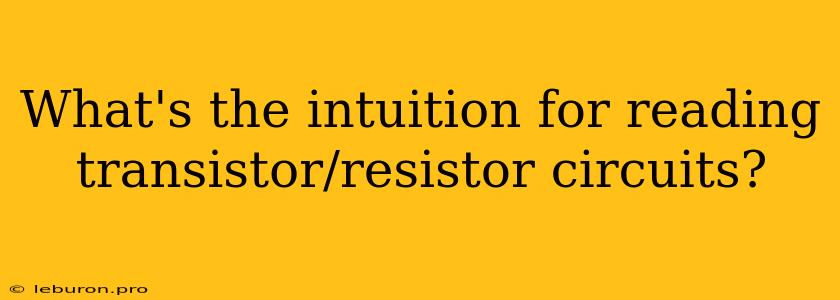Understanding how to read transistor and resistor circuits is a fundamental skill in electronics. It requires developing an intuition for how components interact and influence current flow. This intuition is built upon a foundational understanding of basic electronic principles, such as Ohm's law, Kirchhoff's laws, and the properties of transistors. This article delves into the key concepts that underpin the ability to read transistor/resistor circuits, providing a framework for gaining intuition in this essential aspect of electronics.
Basic Building Blocks: Resistors and Current
At the heart of every circuit lie resistors, the fundamental components that control current flow. Resistors are characterized by their resistance, measured in ohms (Ω), which quantifies their opposition to the flow of electric current. Ohm's law governs the relationship between voltage (V), current (I), and resistance (R): V = I * R.
Understanding Current Flow: Imagine an analogy with water flowing through a pipe. The voltage is akin to the pressure driving the water, the current is the amount of water flowing, and the resistor is like a narrowing in the pipe, restricting the flow. A higher resistance (narrower pipe) results in a lower current flow (less water) for the same voltage (pressure).
Transistors: The Gatekeepers of Current
Transistors, the workhorses of modern electronics, act as controlled switches for current. They come in various types, but we'll focus on field-effect transistors (FETs), specifically MOSFETs. A MOSFET has three terminals:
- Source (S): Where current enters the transistor.
- Drain (D): Where current exits the transistor.
- Gate (G): The control terminal.
Think of the gate as a valve in our water pipe analogy. By applying a voltage to the gate, you control whether current flows between the source and drain.
Understanding Circuit Intuition: A Step-by-Step Guide
To develop intuition for reading transistor/resistor circuits, follow these steps:
- Identify the Power Source: Begin by locating the power source, which provides the voltage driving the circuit. This could be a battery, AC adapter, or any other voltage source.
- Locate the Ground: Find the ground reference point, typically indicated by a ground symbol (a triangle with a vertical line). The ground is the common reference point for all voltages in the circuit.
- Trace the Current Path: Starting from the positive terminal of the power source, trace the path of current flow. Follow the wires and components, noting the direction of current flow.
- Analyze Resistors: Resistors act as "current limiters" and voltage "droppers". Their value in ohms determines how much they resist the current flow. A higher resistance will result in a lower current and a larger voltage drop across the resistor.
- Focus on Transistors: Transistors function as "controlled switches". Analyze the voltage at the gate terminal. If the voltage is above a certain threshold, the transistor will "turn on", allowing current to flow from the source to the drain. The voltage at the gate determines the amount of current that can flow.
The Importance of Circuit Diagrams and Symbols
Circuit diagrams are the language of electronics. Understanding the symbols used in these diagrams is crucial for reading transistor/resistor circuits. Each component has a standard symbol, allowing engineers to represent complex circuits in a compact and easily understandable way. Common transistor/resistor circuit symbols include:
- Resistor: A zigzag line.
- Capacitor: Two parallel lines.
- Inductor: A coil of wire.
- Transistor (MOSFET): A rectangle with a gate terminal connected to the top.
- Diode: A triangle with a line pointing to the cathode.
Practical Applications: Beyond the Basics
The intuition gained by reading transistor/resistor circuits is essential for various applications, such as:
- Amplifier Circuits: Transistors are the building blocks for audio amplifiers, using their ability to amplify weak signals.
- Digital Logic Circuits: Transistors are the fundamental components in digital logic gates like AND, OR, and NOT gates, forming the basis of computer systems.
- Sensors and Actuators: Many sensors and actuators rely on transistors for their operation, enabling them to respond to changes in the environment.
Mastering the Language of Circuits: Ongoing Learning
Developing intuition for reading transistor/resistor circuits is an ongoing process. It requires a combination of theoretical understanding, practical experience, and a willingness to experiment. By diligently studying the fundamentals, practicing circuit analysis, and exploring real-world applications, you'll gradually gain confidence in reading and interpreting transistor/resistor circuits. Remember, the language of electronics is a powerful tool that can unlock a world of innovative possibilities.
